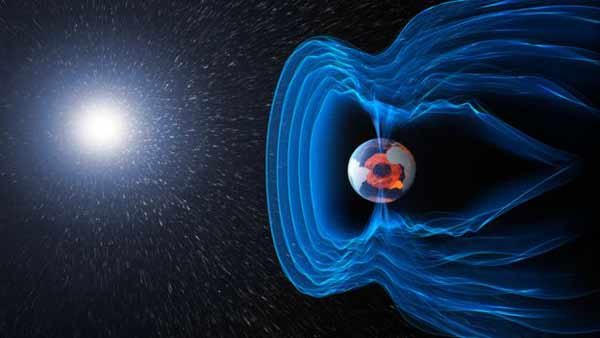
Copenhagen, Denmark (BBN)-Europe's Swarm mission is providing an unprecedented view of Earth's turbulent magnetic field, scientists say.
The three-satellite constellation is now routinely mapping its convulsions, allowing researchers to probe the mechanisms that drive the "invisible shield" in remarkable new detail, reports BBC.
Movies released this week by the Swarm team show how the field strengthens and weakens over time.
They also illustrate the speed at which those changes occur.
"I'm interested in using Swarm data to see what's happening down in the planet's molten outer core, where fluid motions are generating this field," said Chris Finlay from the Technical University of Denmark.
"For me, this is real Earth exploration, because we know so very little about what is going on in that place," he told BBC News.
The planet's magnetic field is a complex, multi-component problem.
As well as that dominant signal generated 3,000km beneath our feet in the swirling convection of liquid iron, there are other contributions pulling on the needle of every compass.
These include the magnetism retained in rocks, and even a very subtle effect derived from the movement of salt water ocean currents.
The Swarm satellites' task is to try to tease apart these various factors, to get a clearer picture of the field's most significant behaviours.
The magnetic "bubble" that protects us from space radiation is known to be in a long-term weakening phase, perhaps heralding one of the periodic flips where north becomes south and south becomes north.
This hasn't happened for 780,000 years. Whether we're actually heading for another reversal now, scientists will only be able to gauge by studying the type of data coming from Swarm.
In the movies showcased here at the Living Planet Symposium in Prague, the satellites' information is critical to the end of the animated sequences, which cover the past 15 years.
One of the videos tracks changes in intensity in the magnetic field. Red is strong; blue is weak (top of page).
The very dark blue region over the South Atlantic is the famous anomaly where the field's weakness allows radiation belts around the Earth to bite down into the atmosphere. It's over this zone where orbiting spacecraft suffer most of their electronic upsets.
The movie reveals the anomaly to be widening, with its centre moving westwards, over Brazil, Uruguay, Paraguay and Argentina.
"Look also at the patch over North America which is decreasing in intensity; whereas over Asia, it's been getting stronger. We haven't really noticed this much before. We see it happening really quite quickly in the last few years," explained Dr Finlay.
"And it's that change in the topology which is also the reason the magnetic north pole is drifting away from the Americas as well. This is a decadal trend and Swarm is allowing us to track it in great detail."
The second movie describes the rate of change in Earth's magnetic field. Regions where changes are slowing are depicted in blue, while red highlights those locations where the changes are speeding up.
An eye-catching feature is the oscillation west of Africa.
"We can now make these maps down at the outer edge of the dynamo, on the core-mantle boundary, and there we see a lot more of the small-scale details of the field change," said Dr Finlay.
"We can use those changes at the core surface to map the flow within the core. And, for example, this positive-negative-positive oscillation - we're seeing changes in the liquid motion within the core. There's an oscillation in the flow in the east-west direction, which is going back and forth on a timescale of about three years."
The European Space Agency's Swarm satellites were launched in 2013.
The three identical spacecraft carry a variety of instruments but their key sensors are state-of-the-art magnetometers that measure the field's strength and the direction.
Two of the satellites, known as Alpha and Charlie, fly in tandem at an altitude of about 450km, and will descend over time.
The third platform, Bravo, is higher up, over 500km, and is drifting away from the other two in its orbital plane.
This geometry enables Swarm to see the magnetic field in three dimensions, and to better gauge its variations in time and space.
BBN/SK/AD